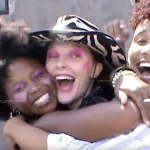Whether you host, travel, top, bottom or side, you’ve heard about new monkeypox outbreaks in LGBTQ+ communities.
We know that the signs and symptoms of monkeypox—an orthopoxvirus—include fever, chills, headache, muscle aches, backache, swollen lymph nodes and exhaustion, as well as a rash that develops into painful pimples and blisters. It’s transmitted through close physical person-to-person contact.
Fortunately, there is a vaccine that can prevent infection and we urge everyone to get vaccinated as quickly as possible. Unfortunately, the vaccine supply is seriously limited for now. But that is changing. Hopefully by Fall there will be enough vaccine for all who want and need it. As a community, we need to be advocating to make certain that we all have access to testing, vaccines and treatment now.
We don’t know when there will be adequate prevention, testing, vaccines and treatment because of inadequate responses from city, state and federal governments.
This isn’t going to be forever, but this is for now. We are the best protection we have against monkeypox until there are enough vaccines for our entire community. We are fighting with the federal government every day to speed up this timeline and make officials act with urgency.
We also know that people are going to have sex, and there are ways to do it that will lower our risk of exposure to the virus. The Centers for Disease Control and Prevention has published guidance about lowering the risk for monkeypox infection during sex, but there are additional harm reduction tools to consider.
Here are six ways we can have safer sex in the time of monkeypox:
1. Stop going to places with lots of sexual activity: Girls, we hate to say it, but it might be time to hang up the group sex and saunas until we all get shots one and two of the vaccine. This is temporary and out of a love for group sex and those who enjoy it. We’ve all seen folks in our community in unbelievable pain, and none of us wants to be in pain or for more folks in our community to suffer. By Fall, we hope to have enough Jynneos vaccines for all who want it. How about instead of a slutty summer, we hold off for a monkeypox-free cider donut anal autumn?
2. Use sex “pods”: Similar to how people established pods to socialize with one another since the COVID-19 pandemic began, creating a pod for sex can be useful. Pod members should monitor for symptoms for a few days (the average time between exposure and symptom onset) after last potential exposure before engaging in sex within pods, and sexual activity should be limited to those within the group. These can be the same members you dance with at parties that have a lot of skin-to-skin contact. This approach is most useful if all pod members are open with their communication.
3. Open and honest communication with potential sex partners: Pod or no pod, it is important to be open about sexual behaviors and potential monkeypox exposure. Before meeting up with a partner, discuss if you or they have had any other recent sex partners or participated in prolonged skin-to-skin contact with others. Discuss your health and whether you have any sores or other side effects. These conversations can help everyone more accurately figure out their level of comfort while considering potential transmission risks.
4. Condom use: The hallmark rash or pox can be present on the genitals and in the perianal area (including internal lesions), and current research and reports from community members have noted that the rash predominately starts in these regions. While condom use would not fully protect against monkeypox, it could help reduce the risk of skin-to-skin contact with lesions in these areas. Condom use would also help reduce the risk of transmission if monkeypox is spread via semen and vaginal fluids, which researchers are currently investigating.

Kim KardashianInstagram/@kimkardashian
5. More clothing: A T-shirt at a circuit party? Long sleeves at the Eagle? Maybe embrace that leather or latex fetish! Think Kim K’s Balenciaga lewks—and who could argue with that? Remember that monkeypox is mostly spread by skin-to-skin contact, so anything you do to reduce the amount of skin you have to contact can make riskier spaces like a bar or circuit party—and even sex!—much more manageable.
6. Take care of yourself and others: If you do test positive for monkeypox, or if you have a flu-like symptoms or a new rash, please stay home, get tested and try to get TPOXX—a safe and likely effective antiviral treatment for monkeypox—if you can. You should also share your close contacts with your city’s health department if you feel comfortable. In some states, the privacy of contact tracing is protected by law and firewalled from any city, state or federal law enforcement, including ICE, thanks to activism around COVID-19 contact tracing. If you don’t want to share your sex partners and other close contacts with city officials, you can always contact them directly and let advise them to get vaccinated. Jynneos vaccination after exposure is thought to protect against monkeypox or reduce the severeness of illness, which is amazing!
We can protect ourselves by sharing accurate information and practicing safe sex. LGBTQ+ communities did it with HIV and COVID-19—and we can do it with monkeypox.
Nicholas Diamond, MPH, Joseph Osmundson, PhD, and Grant Roth, MPH, are coinvestigators of RESPND-MI, a LGBTQ+ community-led survey to map exposure to and symptoms of monkeypox and inform distribution of limited vaccines. Diamond has led public health campaigns at academic medical centers and nonprofits. Osmundson is the author of VIROLOGY: Essays for the Living, the Dead, and the Small Things in Between. Roth is an HIV researcher and clinical studies manager.
Click here for more news about monkeypox.







2 Comments
2 Comments